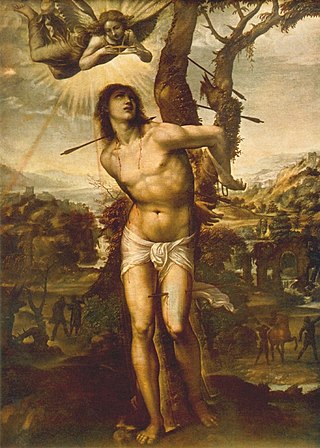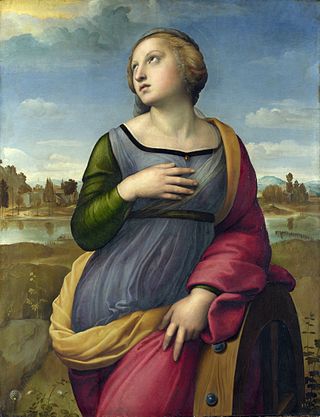
Sebastian was an early Christian saint and martyr. According to traditional belief, he was killed during the Diocletianic Persecution of Christians. He was initially tied to a post or tree and shot with arrows, though this did not kill him. He was, according to tradition, rescued and healed by Irene of Rome, which became a popular subject in 17th-century painting. In all versions of the story, shortly after his recovery he went to Diocletian to warn him about his sins, and as a result was clubbed to death. He is venerated in the Catholic Church and the Orthodox Church.

Pietro Perugino, an Italian Renaissance painter of the Umbrian school, developed some of the qualities that found classic expression in the High Renaissance. Raphael became his most famous pupil.

The Marriage of the Virgin is a painting by the Italian Renaissance master Perugino, although it is now sometimes attributed to his pupil Lo Spagna. It depicts the marriage between Joseph and Mary, and is now in the Musée des Beaux-Arts of Caen, France. Initially commissioned to Pinturicchio for the recently completed cathedral of Perugia, Perugino took over the commission and finished the work around 1500–1504, probably after several periods of stasis.

Saint Placidus (Placitus), along with Saints Eutychius (Euticius), Victorinus and their sister Flavia, Donatus, Firmatus the deacon, Faustus, and thirty others, have been venerated as Christian martyrs. They were said to be martyred either by pirates at Messina or under the Emperor Diocletian.

Panicale is a comune (municipality) in the Province of Perugia in the Italian region Umbria. Located on the eastern slope of Mount Petrarvella, in the southeast of Valdichiana, it overlooks Lake Trasimeno and it is about 35 km far from Perugia.

Saint Catherine of Alexandria is a painting by the Italian Renaissance artist Raphael. In the painting, Catherine of Alexandria is looking upward in ecstasy and leaning on a wheel, an allusion to the breaking wheel of her martyrdom.

Tiberio d'Assisi was an Italian painter of the Renaissance period, active in the early 16th century. He painted in the style of Pietro Perugino. He is also known as Tiberio Diatelevi or Tiberio di Assisi.

Fiesole Cathedral, officially the Cathedral of Saint Romulus of Fiesole, is a Roman Catholic cathedral in Fiesole, Tuscany, central Italy. It is the seat of the Bishop of Fiesole and is dedicated to Saint Romulus.

The Tezi Altarpiece is a painting by the Italian Renaissance painter Pietro Perugino, housed in the Galleria Nazionale dell'Umbria of Perugia, Italy. The work was once associated to a single predella panel portraying the Last Supper, now at the Gemäldegalerie of Berlin.

The Madonna and Child Enthroned with Saints John the Baptist and Sebastian is a painting by the Italian Renaissance artist Pietro Perugino, executed in 1493 and housed in the Uffizi Gallery, Florence.

The Madonna in Glory with Saints is a painting by the Italian Renaissance painter Pietro Perugino, dating to c. 1500–1501. It is housed in the Pinacoteca Nazionale of Bologna, Italy.

Dono Doni, also known as Adone Doni or Dono dei Doni (1505-1575) was an Italian painter of the Renaissance period active mainly in Umbria.
The Martyrdom of St Sebastian may refer to:

The Sant'Agostino Altarpiece is a painting by Perugino, produced in two stages between around 1502 and 1512 and then around 1513 to 1523. The altarpiece's 28, 29 or 30 panels were split up during the Napoleonic suppression of religious houses - most of its panels are now in the Galleria Nazionale dell'Umbria in Perugia. It is notable as the painter's last masterwork before he moved into his late phase producing more provincial commissions.

St Sebastian is one of several paintings of Saint Sebastian by Perugino. It shows him three-quarter length and is signed "P[I]E[T]RUS PERUSINUS PINXIT" on the arrow in his neck. It was painted in 1493–1494. It is now in the Hermitage Museum in St Petersburg.

Saint Sebastian is a c.1495 painting of Saint Sebastian by Perugino, now in the Louvre collection. It was temporarily on display at the Louvre-Lens branch between 2012 and 2017. It is probably the work mentioned in the 17th century inventory of the Barberini collection in Rome, which was later dispersed. Several pieces from it were taken abroad during the 19th century, with St Sebastian being bought by the Louvre in 1896.

St Sebastian is a c.1507 painting of St Sebastian by Perugino. It is thought to be an autograph copy of his original in the Louvre - it is near identical to that work, only lacking its inscription and its ruins. It is now in the São Paulo Museum of Art.

St Sebastian between St Roch and St Peter is a fragment of a fresco by Perugino, painted around 1478 in the church of Santa Maria Assunta in Cerqueto, Italy. It was his first depiction of Saint Sebastian, a subject to which he would frequently return. To the left is St Roch and to the right St Peter.

St Sebastian is an oil on panel painting by Perugino, completed c. 1490. The painting has been in the Nationalmuseum in Stockholm since 1928. It is one of the artist's earliest depictions of Saint Sebastian, showing him as an ephebos, or male adolescent, unlike his later treatments based on the Doryphoros, such as that in the Louvre. It is signed "Petrus Perusinus pinxit".


















